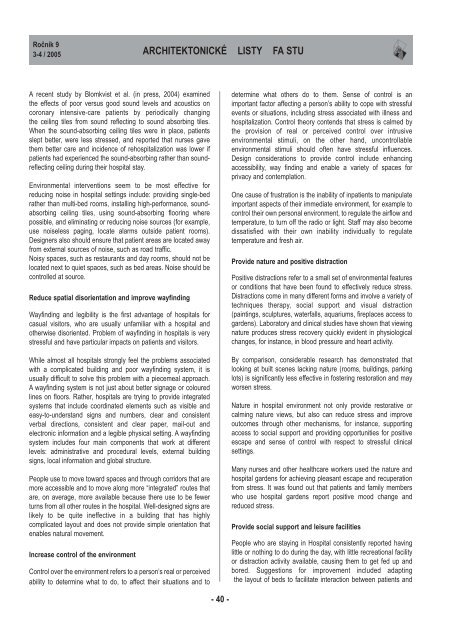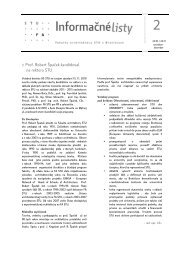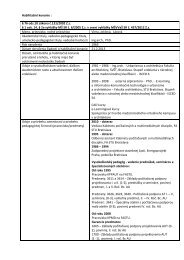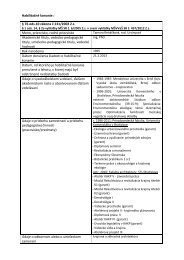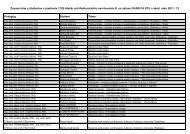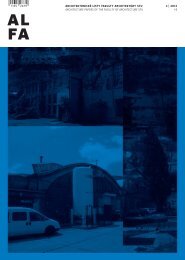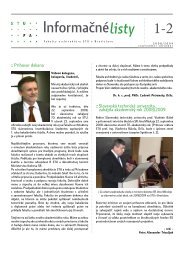ALFA 3-4/2005 - Fakulta architektúry STU
ALFA 3-4/2005 - Fakulta architektúry STU
ALFA 3-4/2005 - Fakulta architektúry STU
Create successful ePaper yourself
Turn your PDF publications into a flip-book with our unique Google optimized e-Paper software.
Ročník 9<br />
3-4 / <strong>2005</strong> ARCHITEKTONICKÉ LISTY FA <strong>STU</strong><br />
A recent study by Blomkvist et al. (in press, 2004) examined<br />
the effects of poor versus good sound levels and acoustics on<br />
coronary intensive-care patients by periodically changing<br />
the ceiling tiles from sound reflecting to sound absorbing tiles.<br />
When the sound-absorbing ceiling tiles were in place, patients<br />
slept better, were less stressed, and reported that nurses gave<br />
them better care and incidence of rehospitalization was lower if<br />
patients had experienced the sound-absorbing rather than soundreflecting<br />
ceiling during their hospital stay.<br />
Environmental interventions seem to be most effective for<br />
reducing noise in hospital settings include: providing single-bed<br />
rather than multi-bed rooms, installing high-performance, soundabsorbing<br />
ceiling tiles, using sound-absorbing flooring where<br />
possible, and eliminating or reducing noise sources (for example,<br />
use noiseless paging, locate alarms outside patient rooms).<br />
Designers also should ensure that patient areas are located away<br />
from external sources of noise, such as road traffic.<br />
Noisy spaces, such as restaurants and day rooms, should not be<br />
located next to quiet spaces, such as bed areas. Noise should be<br />
controlled at source.<br />
Reduce spatial disorientation and improve wayfinding<br />
Wayfinding and legibility is the first advantage of hospitals for<br />
casual visitors, who are usually unfamiliar with a hospital and<br />
otherwise disoriented. Problem of wayfinding in hospitals is very<br />
stressful and have particular impacts on patients and visitors.<br />
While almost all hospitals strongly feel the problems associated<br />
with a complicated building and poor wayfinding system, it is<br />
usually difficult to solve this problem with a piecemeal approach.<br />
A wayfinding system is not just about better signage or coloured<br />
lines on floors. Rather, hospitals are trying to provide integrated<br />
systems that include coordinated elements such as visible and<br />
easy-to-understand signs and numbers, clear and consistent<br />
verbal directions, consistent and clear paper, mail-out and<br />
electronic information and a legible physical setting. A wayfinding<br />
system includes four main components that work at different<br />
levels: administrative and procedural levels, external building<br />
signs, local information and global structure.<br />
People use to move toward spaces and through corridors that are<br />
more accessible and to move along more “integrated” routes that<br />
are, on average, more available because there use to be fewer<br />
turns from all other routes in the hospital. Well-designed signs are<br />
likely to be quite ineffective in a building that has highly<br />
complicated layout and does not provide simple orientation that<br />
enables natural movement.<br />
Increase control of the environment<br />
Control over the environment refers to a person’s real or perceived<br />
ability to determine what to do, to affect their situations and to<br />
- 40 -<br />
determine what others do to them. Sense of control is an<br />
important factor affecting a person’s ability to cope with stressful<br />
events or situations, including stress associated with illness and<br />
hospitalization. Control theory contends that stress is calmed by<br />
the provision of real or perceived control over intrusive<br />
environmental stimuli, on the other hand, uncontrollable<br />
environmental stimuli should often have stressful influences.<br />
Design considerations to provide control include enhancing<br />
accessibility, way finding and enable a variety of spaces for<br />
privacy and contemplation.<br />
One cause of frustration is the inability of inpatients to manipulate<br />
important aspects of their immediate environment, for example to<br />
control their own personal environment, to regulate the airflow and<br />
temperature, to turn off the radio or light. Staff may also become<br />
dissatisfied with their own inability individually to regulate<br />
temperature and fresh air.<br />
Provide nature and positive distraction<br />
Positive distractions refer to a small set of environmental features<br />
or conditions that have been found to effectively reduce stress.<br />
Distractions come in many different forms and involve a variety of<br />
techniques therapy, social support and visual distraction<br />
(paintings, sculptures, waterfalls, aquariums, fireplaces access to<br />
gardens). Laboratory and clinical studies have shown that viewing<br />
nature produces stress recovery quickly evident in physiological<br />
changes, for instance, in blood pressure and heart activity.<br />
By comparison, considerable research has demonstrated that<br />
looking at built scenes lacking nature (rooms, buildings, parking<br />
lots) is significantly less effective in fostering restoration and may<br />
worsen stress.<br />
Nature in hospital environment not only provide restorative or<br />
calming nature views, but also can reduce stress and improve<br />
outcomes through other mechanisms, for instance, supporting<br />
access to social support and providing opportunities for positive<br />
escape and sense of control with respect to stressful clinical<br />
settings.<br />
Many nurses and other healthcare workers used the nature and<br />
hospital gardens for achieving pleasant escape and recuperation<br />
from stress. It was found out that patients and family members<br />
who use hospital gardens report positive mood change and<br />
reduced stress.<br />
Provide social support and leisure facilities<br />
People who are staying in Hospital consistently reported having<br />
little or nothing to do during the day, with little recreational facility<br />
or distraction activity available, causing them to get fed up and<br />
bored. Suggestions for improvement included adapting<br />
the layout of beds to facilitate interaction between patients and


